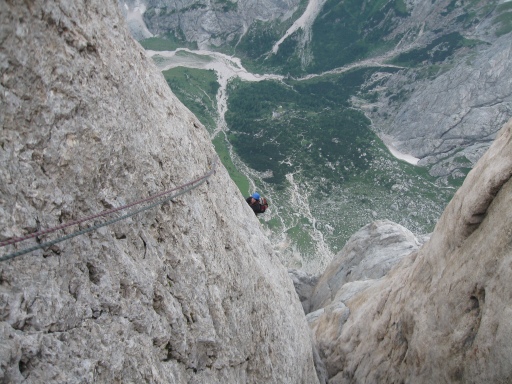Marmolada – Punta d’Ombretta (3247 m n. m.) – Via Don Quixote (VI° /VI°, A0; 950 m)
After a long time the weather looks good and the mountains three days before the weekend, ie. no thunderstorms. Our goal is the way Don Quixote in the south wall of the Marmolada. If anyone cares, after what we climbed, a brief description of the geology will find at the end of the post.
On Friday evening we set off with Adam, Buri Honza Plock.
Buri s Honzou se ubytují na chatě a pomohou nám s věcmi k nástupu. Hned na začátku se nám podaří špatně nastoupit, protože cesta přes komín ubíhající vlevo vzhůru nevypadá moc lákavě. Začneme tedy moc vpravo a pak se komplikovaně dostáváme do správné linie. Jakmile se nám to povede, prostupujeme první délky celkem rychle. Začíná se šeřit, ale bivakovací plošina je stále v nedohlednu. Orientace podle několika nákresů cesty, které máme, také není snadná. Nakonec skončíme ve štandu ze tří starých skob a nevíme, jestli pokračovat doprava či doleva. Skoby vedou na obě strany. Navíc už je skoro tma. Po krátkém rozhodování vyhrává varianta zůstat a pokusit se alespoň trochu si přes noc odpočinout. Pokračovat za tmy, po vlastním jištění a nejistou cestou by bylo docela riskantní. U štandu je polička na sezení asi tak na půl zadku, takže většinu noci strávíme snahou se na ní alespoň chvíli udržet, abychom pořád neviseli v sedáku. Nakonec si ze smyček udělám i takové „stupátko“ pro nohy, což docela uleví. Ve společném žďáráku, péřovém spacáku a v péřovkách ani není zima, většinou. Se spánkem je to horší. Při sledování pohybu hvězd občas upadnu do spánku, ale jen tak na pár minut. Když jsou po třetí hodině ráno konečně vidět světla prvních čelovek směřujících k nástupům, mám radost a těším se na úsvit.
It's pretty chilly and we do not want the sleeping bag.
After them another piece brittle and difficult to provide a route to the top. Here we wander a bit, but eventually it Adam hit correctly. Last Chodák the length of the loose stones. Happy we find ourselves with a sunset on top. The views are great, do a few pictures and quickly descend, rappel to catch the light.
Total no problems are found Stand and slaňujeme the glacier.
Current Dolomites have a deep and relatively uniform geological basis of metamorphic rocksOr crystalline břidlice. On top of this foundation covers a huge plate of porphyritic rocks called "Bolzanoa '(ignimbrit, tuf a lava) Inserted with the huge and long periods of volcanic activity during the surface (About 250 million years ago). Above it are sandy deposits of a bound river silt. They are inserted together with the calcareous depozity arising from expansion to Mesozoic sea called TethysThat existed more than 180 million years ago. At the bottom of the sea with the help of new volcanic activity formed a rock massifs, which are gradually formed until today. Dolomite is composed of chemically calcium carbonate a Magnesium. Rocks are composed of dolomitu containing 50 – 90% of carbonates, replacing the calcium carbonate itself. This affects the shapes of the Dolomite peaks, towers, cornices or inclined planes. Rock walls are less resistant erosion thus gaining its slope and ridges on rozeklanosti (source: wikipedia).























